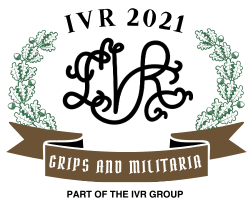In this blog post, I want to explain the different markings found on German Dienstglasses. These binoculars were a crucial tool for the German military, offering rangefinding capability and durability in various conditions, from the cold of the east front to the heat of the africa dessert. Let’s take a closer look at the details and significance of the engravings found on these historical optics and what they mean. For IVR2021’s selection of Dienstglasses and accesories available; click here.
Pre-War Models

Most equipment used by the Germans leading up to and during ww2 can be placed in 3 general groups. Pre-war, early-war and late-war.
On the pre-war models of the 6×30 Dienstglas binoculars, the left side of the prism plate typically features the factory logo engraving. This engraving is usually the only marking on this side and identifies the manufacturer of the binoculars. Some of the well-known manufacturers include Carl Zeiss, Leitz, and Hensoldt. But also lesser known optics manufacturers like Busch, Rodenstock and Voigtlander were Dienstglas manufacturers.
The right side of the binoculars carries more detailed information, from top to bottom they mostly feature:
- Dienstglas: Translates to “Service glass” or “Army glass,” indicating that these binoculars were intended for military use.
- 6×30: This denotes the magnification power (6x) and the objective lens diameter (30mm). The 6x magnification allows for clear and stable viewing, while the 30mm lenses ensure sufficient light gathering for better visibility.
- Serial Number: Each pair of binoculars has a unique serial number, which can often help in dating the production year and tracking the manufacturing details.
- H.6400: Indicates the presence of a rangefinder in the right eyepiece. The rangefinder was a vital feature for military personnel, aiding in distance estimation and target acquisition. To learn about how the rangefinder works click here.
EARLY-WAR MODELs

With the onset of World War II, the engravings on the binoculars evolved. Starting from 1939, the left side of the binoculars now featured a three-letter ordnance code instead of the full logo. This coding system was implemented to maintain secrecy about the production locations. The right side plate remained mostly the same as the pre-war models.
LATE-WAR MODELS

Nearing the end of the war, the Germans were running out of materials and time. This meant they had to find ways to use less materials and make equipment faster. Almost all weapons and equipment were affected by this. Optics as well.
Late-war models still feature the necessary information and detail to be effectively used at the front, while having been simplified as much as possible.
– The coating has been made simpler, by painting it instead of using leather or leather substitutes like early and pre-war models.
– The ocular indicators have been removed or greatly simplified.
– The axle cover with adjustment angle has been completely removed on both sides, with no more accommodation for the screws.
– The left side of the prism plate is now empty.
– The right side of the prism plate now features all information of the binocular, exluding the H/6400 on most models. From top to bottom this is:
Dienstglas
6x30
Serial Number
Factory code
GREASE CODES

Alongside the factory logo or ordnance code, there is sometimes also a grease code present on either side of the prism plates.
The grease code indicates the type of lubrication used and the temperature range within which the binoculars can operate effectively. There are four grease codes, each represented by a symbol:
- KF
- Circle (O)
- Triangle (Δ)
- Plus (+)
These codes changed during the course of the war and can be used to roughly date the optic they are found on. ensure that the binoculars can function in extreme conditions, typically ranging from -40°C to +50°C. If a binocular was revised or repaired during the war, it might display two different grease codes on one plate, reflecting the different types of lubrication used over time.
THE M MARKING

Some of the standard-issue binoculars have an additional “M” engraved on the right plate. Contrary to popular belief, this “M” does not stand for “Marine” (Navy). Instead, it signifies “Metric” or “Metrisch” in German. This marking was added to early war models when all factories transitioned to using metric threading. This change ensured uniformity and standardization across all manufacturing units, simplifying maintenance and repairs.
WAFFENAMT MARKING

Some pre-war and early-war glasses were WaA marked. Either on the bridge between the left and right side of the housing, or on the oculars. Very few were marked with the WaA.
